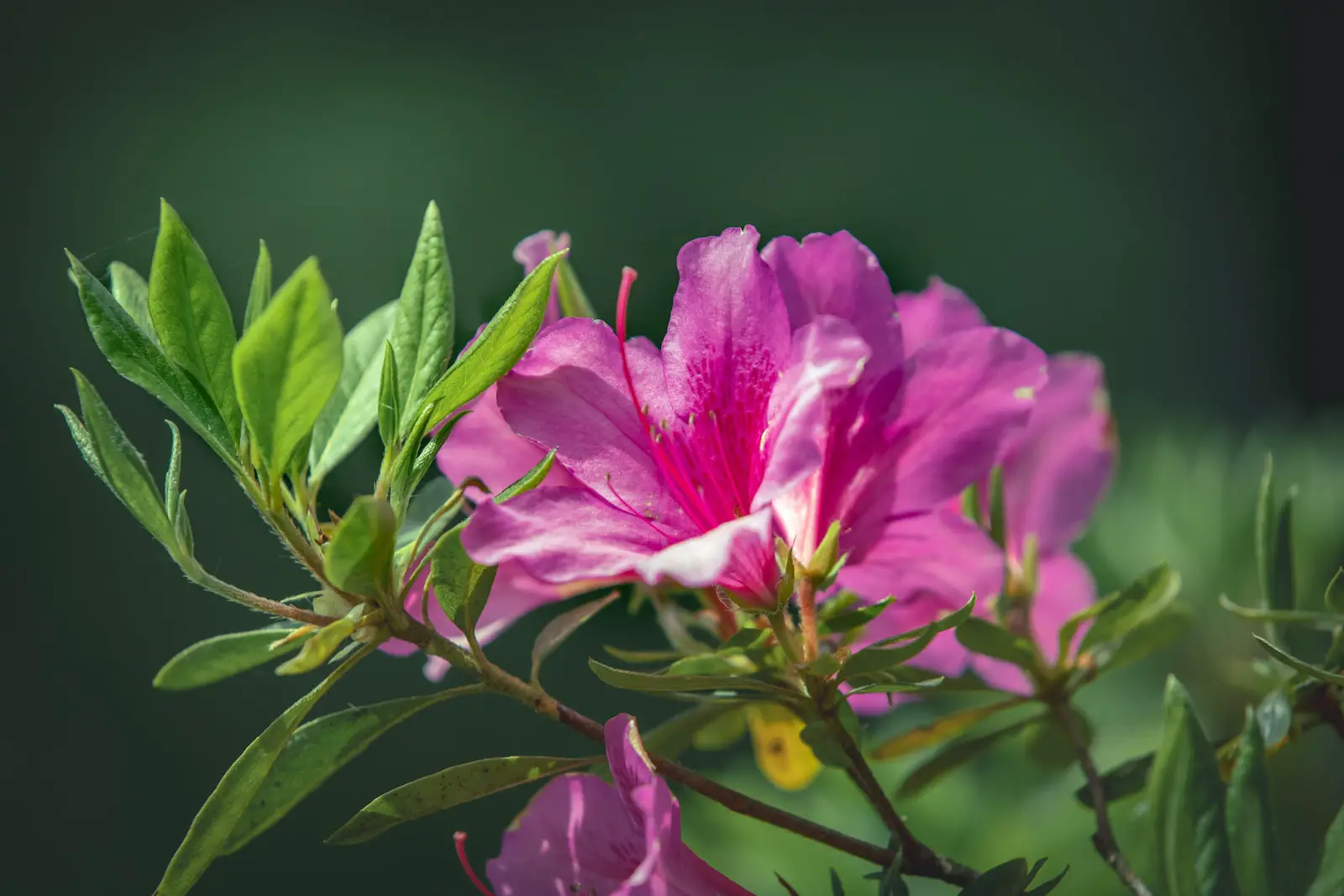Azaleas, part of the Rhododendron family, are flowering shrubs known for their vibrant and enchanting blossoms. With over 10,000 different types, Azaleas can be found in various shades, including white, pink, purple, and red. Their magnificent blooms make them a centerpiece in many gardens, providing a splash of color in the spring and sometimes even in the fall.
Native to various parts of the world, including Asia, North America, and Europe, Azaleas have been cultivated for centuries. Their adaptability and vast array of types make them suitable for various climates and garden styles. The lush green foliage of Azaleas offers a perfect backdrop for the delicate flowers, enhancing the garden’s overall appearance even when they’re not in bloom.
Azaleas can be used in numerous landscaping applications, from hedges and borders to standalone specimens. They are commonly found in Japanese gardens, symbolizing beauty and elegance. The maintenance of Azaleas is fairly straightforward, making them a favorite choice among gardeners of all skill levels.
| Attribute | Details |
|---|---|
| Common Names | Azaleas |
| Botanical Name | Rhododendron spp. |
| Family | Ericaceae |
| Plant Type | Flowering Shrub |
| Mature Size | 2-8 feet tall, depending on species |
| Sun Exposure | Partial Sun/Shade |
| Soil Type | Acidic, Well-Drained |
| Hardiness Zones | 4-9 |
| Native Area | Asia, North America, Europe |
Azaleas Care
Azaleas require a delicate balance of sunlight, soil pH, and moisture. They thrive best in partial sun or dappled shade. Planting them in a location with morning sun and afternoon shade often works well. The soil should be acidic, with a pH ranging from 4.5 to 6.0, and must be well-draining to prevent root rot.
Watering Azaleas should be done carefully, keeping the soil consistently moist but never soggy. Mulching around the base of the plant helps retain moisture and suppresses weeds. Care should also be taken to shelter the plant from strong winds, as Azaleas are somewhat sensitive to extreme weather.
Light Requirement for Azaleas
Azaleas do best in partial sun or filtered shade. Direct sunlight, especially during hot afternoons, can scorch the leaves and flowers. An area with morning sun followed by shade in the afternoon generally offers the ideal lighting condition for Azaleas.
Soil Requirements for Azaleas
Soil for Azaleas must be acidic, with a pH level between 4.5 to 6.0. Organic matter like peat moss or compost can be added to enrich the soil and maintain acidity. Well-drained soil is essential to prevent root rot.
Water Requirements for Azaleas
Regular watering that keeps the soil consistently moist is vital for Azaleas. They do not tolerate drought well, so a consistent water supply, particularly in the growing season, is essential. Avoid overwatering, as this can lead to root diseases.
Temperature and Humidity
Azaleas prefer moderate temperatures and are hardy in USDA zones 4-9. Some varieties can tolerate colder temperatures, but generally, they prefer a temperate climate. High humidity levels are beneficial, particularly during blooming.
Fertilizer
Azaleas benefit from a specific fertilizer formulated for acid-loving plants. A balanced slow-release fertilizer can be applied in late spring after blooming. Over-fertilizing should be avoided, as it can harm the plant.
Pruning Azaleas
Pruning is best done right after the flowers have bloomed. This allows the plant to develop buds for the next season. Dead or diseased branches should be removed, and the plant can be shaped according to preference.
Propagating Azaleas
Azaleas can be propagated through cuttings, taken in late spring or early summer. Rooting hormone and well-drained soil help ensure success.
How To Grow Azaleas From Seed
Growing Azaleas from seed is a longer process and requires patience. Seeds should be sown in well-drained soil, kept moist, and placed in a cold frame or similar environment. Germination may take several months.
Common Pests & Plant Diseases
Aphids
Aphids can be treated with insecticidal soap or neem oil.
Powdery Mildew
This fungus appears as a white powdery substance on leaves and can be controlled with proper airflow and fungicides.
Common Problems With Azaleas
Yellowing Leaves
Caused by alkaline soil or iron deficiency, this can be corrected by adjusting soil pH or adding a suitable fertilizer.
Bud Drop
This often occurs when the plant is stressed due to incorrect watering, extreme temperature changes, or poor soil.
Pro Tips
- Choose the right variety for your climate and soil type.
- Plant Azaleas in a location protected from strong winds.
- Test soil pH and amend as needed to maintain acidity.
- Monitor water levels closely, particularly in hot weather.
- Consider planting Azaleas near other acid-loving plants like Rhododendrons.




